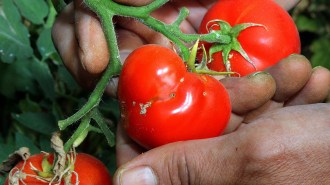Bt Cotton: Yields up in India; pests low in Arizona
The two cotton-growing centers could hardly differ more. But small farms in India and industrial fields in Arizona both provide case studies that show the bright side of a widespread genetically engineered crop.



The crop, Bt cotton, has borrowed a toxin gene from the bacterium Bacillus thuringiensis to make its own pesticide. According to a report in the Feb. 7 Science, Bt cotton has raised yields some 80 percent on small farm plots in India compared with neighboring plots growing conventional cotton. It’s the first time that tests have found a whopping yield improvement from switching to a Bt crop, says agricultural economist Matin Qaim of the University of Bonn in Germany. The same jump might also show up in other tropical and subtropical farming regions, say Qaim and coauthor David Zilberman of the University of California, Berkeley.
On the other side of the world, clusters of Arizona cotton fields with Bt plants on more than 60 percent of the acreage have managed to suppress the local populations of the dreaded pink bollworm, says entomologist Yves Carrière of the University of Arizona in Tucson. The analysis represents the first time that observers have documented such a drop, Carrière and his colleagues report in an upcoming Proceedings of the National Academy of Sciences.
In India, when a seed company in 2001 tested Bt cotton varieties, Qaim and Zilberman received funding from the German government’s research arm to monitor the results.
Standard pesticides are hard to get and expensive in India, so farmers typically lose much of their crops to insects. In this setting, the Bt cotton brought hefty increases in yields, says Qaim. In contrast, in the United States and China, Bt cotton overall has posted less than a 10 percent gain in yield over regular varieties.
Even with that small yield boost on Chinese farms, Bt cotton decreased use of pesticides and thus dramatically increased a typical farm’s income in recent years, says Per Pinstrup-Andersen of Cornell University. “The public sector has to invest in research for the good of poor farmers–including genetic engineering,” he says.
“The thing that concerns me is that insects will develop resistance.”
In Arizona, Carrière and his colleagues analyzed data on cotton varieties and pink bollworm infestations from 1991–5 years before the introduction of Bt cotton–until 2001. Their work was partially funded by a cotton-growers association. In regions with extensive plantings of Bt varieties, the researchers noted that bollworm populations the next spring started out at less than a sixth of what they had been with conventional cotton. Bt crops kill more than 90 percent of the bollworm larvae that hatch on them, so adult insects that meander into a Bt field “are wasting eggs,” says Carrière.
There has been a long-standing debate in the entomological community about whether a high density of Bt crops could wallop pests hard enough to reduce local populations beyond one growing season, says entomologist Fred Gould of North Carolina State University at Raleigh. The Arizona work shows that this is possible, he notes.
Carrière cautions that success depends on avoiding pesticide resistance. Lab work has shown that pink bollworms already carry gene variants that in certain combinations can provide immunity. Arizona scientists monitor yearly fluctuations in the prevalence of these variants in insects in the field but haven’t observed resistant insects. Carrière says, “So far, so good.”
****************
If you have a comment on this article that you would like considered for publication in Science News, please send it to editors@sciencenews.org.
To subscribe to Science News (print), go to https://www.kable.com/pub/scnw/
subServices.asp.
To sign up for the free weekly e-LETTER from Science News, go to http://www.sciencenews.org/subscribe_form.asp.






